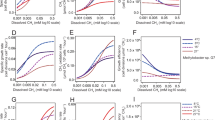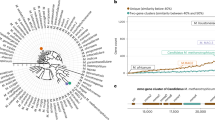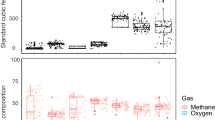Abstract
In the United Kingdom, landfills are the primary anthropogenic source of methane emissions. Methanotrophic bacteria present in landfill biocovers can significantly reduce methane emissions via their capacity to oxidize up to 100% of the methane produced. Several biotic and abiotic parameters regulate methane oxidation in soil, such as oxygen, moisture, methane concentration and temperature. Earthworm-mediated bioturbation has been linked to an increase in methanotrophy in a landfill biocover soil (AC Singer et al., unpublished), but the mechanism of this trophic interaction remains unclear. The aims of this study were to determine the composition of the active methanotroph community and to investigate the interactions between earthworms and bacteria in this landfill biocover soil where the methane oxidation activity was significantly increased by the earthworms. Soil microcosms were incubated with 13C-CH4 and with or without earthworms. DNA and RNA were extracted to characterize the soil bacterial communities, with a particular emphasis on methanotroph populations, using phylogenetic (16S ribosomal RNA) and functional methane monooxygenase (pmoA and mmoX) gene probes, coupled with denaturing gradient-gel electrophoresis, clone libraries and pmoA microarray analyses. Stable isotope probing (SIP) using 13C-CH4 substrate allowed us to link microbial function with identity of bacteria via selective recovery of ‘heavy’ 13C-labelled DNA or RNA and to assess the effect of earthworms on the active methanotroph populations. Both types I and II methanotrophs actively oxidized methane in the landfill soil studied. Results suggested that the earthworm-mediated increase in methane oxidation rate in the landfill soil was more likely to be due to the stimulation of bacterial growth or activity than to substantial shifts in the methanotroph community structure. A Bacteroidetes-related bacterium was identified only in the active bacterial community of earthworm-incubated soil but its capacity to actually oxidize methane has to be proven.
Similar content being viewed by others
Log in or create a free account to read this content
Gain free access to this article, as well as selected content from this journal and more on nature.com
or
References
Altschul SF, Gish W, Miller W, Myers EW, Lipman DJ . (1990). Basic local alignment search tool. J Mol Biol 215: 403–410.
Binet F, Le Bayon RC . (1998). Space–time dynamics in situ of earthworm casts under temperate cultivated soils. Soil Biol Biochem 31: 85–93.
Binet F, Trehen P . (1992). Experimental microcosm study of the role of Lumbricus terrestris (oligochaeta:lumbricidae) on nitrogen dynamics in cultivated soils. Soil Biol Biochem 24: 1501–1506.
Bodelier PL, Roslev P, Henckel T, Frenzel P . (2000). Stimulation by ammonium-based fertilizers of methane oxidation in soil around rice roots. Nature 403: 421–424.
Bodrossy L, Holmes EM, Holmes AJ, Kovacs KL, Murrell JC . (1997). Analysis of 16S rRNA and methane monooxygenase gene sequences reveals a novel group of thermotolerant and thermophilic methanotrophs, Methylocaldum gen. nov. Arch Microbiol 168: 493–503.
Bodrossy L, Stralis-Pavese N, Konrad-Koszler M, Weilharter A, Reichenauer TG, Schofer D et al. (2006). mRNA-based parallel detection of active methanotroph populations by use of a diagnostic microarray. Appl Environ Microbiol 72: 1672–1676.
Bodrossy L, Stralis-Pavese N, Murrell JC, Radajewski S, Weilharter A, Sessitsch A . (2003). Development and validation of a diagnostic microbial microarray for methanotrophs. Environ Microbiol 5: 566–582.
Boeckx P, Van Cleemput O, Villaralvo I . (1996). Methane emission from a landfill and the methane oxidising capacity of its covering soil. Soil Biol Biochem 28: 1397–1405.
Bogner J, Spokas K, Burton E, Sweeney R, Corona V . (1995). Landfills as atmospheric methane sources and sinks. Chemosphere 31: 4119–4130.
Borjesson G, Sundh I, Svensson B . (2004). Microbial oxidation of CH4 at different temperatures in landfill cover soils. FEMS Microbiol Ecol 48: 305–312.
Borjesson G, Sundh I, Tunlid A, Frostegard A, Svensson BH . (1998). Microbial oxidation of CH4 at high partial pressures in an organic landfill cover soil under different moisture regimes. FEMS Microbiol Ecol 26: 207–217.
Bourne DG, McDonald IR, Murrell JC . (2001). Comparison of pmoA PCR primer sets as tools for investigating methanotroph diversity in three Danish soils. Appl Environ Microbiol 67: 3802–3809.
Bowman JP, McCammon SA, Skerratt JH . (1997). Methylosphaera hansonii gen. nov., sp. nov., a psychrophilic, group I methanotroph from Antarctic marine-salinity, meromictic lakes. Microbiology 143: 1451–1459.
Bowman JP, Sly LI, Nichols PD, Hayward AC . (1993). Revised taxonomy of the methanotrophs: description of Methylobacter gen. nov., emendation of Methylococcus, validation of Methylosinus and Methylocystis species, and a proposal that the family Methylococcaceae includes only the group I methanotrophs. Int J Syst Bacteriol 43: 735–753.
Bürgmann H, Widmer F, Sigler WV, Zeyer J . (2003). mRNA extraction and reverse transcription-PCR protocol for detection of nifH gene expression by Azotobacter vinelandii in soil. Appl Environ Microbiol 69: 1928–1935.
Buse A . (1990). Influence of earthworms on nitrogen fluxes and plant growth in cores taken from variously managed upland pastures. Soil Biol Biochem 22: 775–780.
Cébron A, Bodrossy L, Chen Y, Singer AC, Thompson IP, Prosser JI et al. (2007). Identity of active methanotrophs in landfill cover soil as revealed by DNA-stable isotope probing. FEMS Microbiology Ecology 62: 12–23.
Chan ASK, Parkin TB . (2000). Evaluation of potential inhibitors of methanogenesis and methane oxidation in a landfill cover soil. Soil Biol Biochem 32: 1581–1590.
Clapperton MJ, Lee NO, Binet F, Conner RL . (2001). Earthworms indirectly reduce the effects of take-all (Gaeumannomyces graminis var. tritici) on soft white spring wheat (Triticum aestivum cv. Fielder). Soil Biol Biochem 33: 1531–1538.
Costello AM, Lidstrom ME . (1999). Molecular characterization of functional and phylogenetic genes from natural populations of methanotrophs in lake sediments. Appl Environ Microbiol 65: 5066–5074.
Crossman Z, Abraham F, Evershed RP . (2004). Stable isotope pulse-chasing and compound specific stable carbon isotope analysis of phospholipid fatty acids to assess methane oxidizing bacterial populations in landfill cover soils. Environ Sci Technol 38: 1359–1367.
Daniel O, Anderson JM . (1992). Microbial biomass and activity in contrasting soil materials after passage through the gut of the earthworm Lumbricus rubellus Hoffmeister. Soil Biol Biochem 24: 465–470.
Dedysh SN, Khmelenina VN, Suzina NE, Trotsenko YA, Semrau JD, Liesack W et al. (2002). Methylocapsa acidiphila gen. nov., sp. nov., a novel methane-oxidizing and dinitrogen-fixing acidophilic bacterium from Sphagnum bog. Int J Syst Evol Microbiol 52: 251–261.
Dedysh SN, Liesack W, Khmelenina VN, Suzina NE, Trotsenko YA, Semrau JD et al. (2000). Methylocella palustris gen. nov., sp. nov., a new methane-oxidizing acidophilic bacterium from peat bogs, representing a novel subtype of serine-pathway methanotrophs. Int J Syst Evol Microbiol 50: 955–969.
Dedysh SN, Panikov NS, Liesack W, Grosskopf R, Zhou J, Tiedje JM . (1998). Isolation of acidophilic methane-oxidizing bacteria from northern peat wetlands. Science 282: 281–284.
Dumont MG, Murrell JC . (2005). Community-level analysis: key genes of aerobic methane oxidation. In: Leadbetter J (ed). Methods in Enzymology. SPI: St Louis, MO, USA, vol. 397, pp 413–427.
Graham DW, Chaudhary JA, Hanson RS, Arnold RG . (1993). Factors affecting competition between type I and type II methanotrophs in two-organism continuous-flow reactors. Microb Ecol 25: 1–18.
Hanson RS, Hanson TE . (1996). Methanotrophic bacteria. Microbiol Rev 60: 439–471.
Haynes RJ, Fraser PM, Piercy JE, Tregurtha RJ . (2003). Casts of Aporrectodea caliginosa (Savigny) and Lumbricus rubellus (Hoffmeister) differ in microbial activity, nutrient availability and aggregate stability: The 7th International Symposium on Earthworm Ecology, Cardiff, Wales 2002. Pedobiologia 47: 882–887.
Henckel T, Roslev P, Conrad R . (2000). Effects of O2 and CH4 on presence and activity of the indigenous methanotrophic community in rice field soil. Environ Microbiol 2: 666–679.
Holmes AJ, Costello A, Lidstrom ME, Murrell JC . (1995). Evidence that participate methane monooxygenase and ammonia monooxygenase may be evolutionarily related. FEMS Microbiol Lett 132: 203–208.
Horz HP, Yimga MT, Liesack W . (2001). Detection of methanotroph diversity on roots of submerged rice plants by molecular retrieval of pmoA, mmoX, mxaF, and 16S rRNA and ribosomal DNA, including pmoA-based terminal restriction fragment length polymorphism profiling. Appl Environ Microbiol 67: 4177–4185.
Hutchens E, Radajewski S, Dumont MG, McDonald IR, Murrell JC . (2004). Analysis of methanotrophic bacteria in Movile cave by stable isotope probing. Environ Microbiol 6: 111–120.
Jones CG, Lawton JH, Shachak M . (1994). Organisms as ecosystem engineers. Oïkos 69: 373–386.
Jones HA, Nedwell DB . (1993). Methane emission and methane oxidation in land-fill cover soil. FEMS Microbiol Lett 102: 185–195.
Kightley D, Nedwell DB, Cooper M . (1995). Capacity for methane oxidation in landfill cover soils measured in laboratory-scale soil microcosms. Appl Environ Microbiol 61: 592–601.
Kolb S, Knief C, Stubner S, Conrad R . (2003). Quantitative detection of methanotrophs in soil by novel pmoA-targeted real-time PCR assays. Appl Environ Microbiol 69: 2423–2429.
Kumar S, Tamura K, Nei M . (2004). MEGA3: Integrated software for molecular evolutionary genetics analysis and sequence alignment. Brief Bioinform 5: 150–163.
Lane DJ . (1991). 16S/23S rRNA sequencing. In: Stackebrandt E, Goodfellow M (eds). Nucleic Acid Techniques in Bacterial Systematics. John Wiley and Sons: New York, NY, pp 115–175.
Lin JL, Radajewski S, Eshinimaev BT, Trotsenko YA, McDonald IR, Murrell JC . (2004). Molecular diversity of methanotrophs in Transbaikal soda lake sediments and identification of potentially active populations by stable isotope probing. Environ Microbiol 6: 1049–1060.
Lueders T, Wagner B, Claus P, Friedrich MW . (2004). Stable isotope probing of rRNA and DNA reveals a dynamic methylotroph community and trophic interactions with fungi and protozoa in oxic rice field soil. Environ Microbiol 6: 60–72.
Luepromchai E, Singer AC, Yang CH, Crowley DE . (2002). Interactions of earthworms with indigenous and bioaugmented PCB-degrading bacteria. FEMS Microbiol Ecol 41: 191–197.
Manefield M, Griffiths R, McNamara NP, Sleep D, Ostle N, Whiteley A . (2007). Insights into the fate of a 13C labelled phenol pulse for stable isotope probing (SIP) experiments. J Microbiol Methods 69: 340–344.
Manefield M, Whiteley AS, Griffiths RI, Bailey MJ . (2002). RNA stable isotope probing, a novel means of linking microbial community function to phylogeny. Appl Environ Microbiol 68: 5367–5373.
Molin S, Givskov M . (1999). Application of molecular tools for in situ monitoring of bacterial growth activity. Environ Microbiol 1: 383–391.
Morris SA, Radajewski S, Willison TW, Murrell JC . (2002). Identification of the functionally active methanotroph population in a peat soil microcosm by stable-isotope probing. Appl Environ Microbiol 68: 1446–1453.
Mulongoy K, Bedoret A . (1989). Properties of worm casts and surface soils under various plant covers in the humid tropics. Soil Biol Biochem 21: 197–203.
Mummey D, Holben W, Six J, Stahl P . (2006). Spatial stratification of soil bacterial populations in aggregates of diverse soils. Microb Ecol 51: 404–411.
Murrell JC, McDonald IR, Bourne DG . (1998). Molecular methods for the study of methanotroph ecology. FEMS Microbiol Ecol 27: 103–114.
Murrell JC, McDonald IR, Gilbert B . (2000). Regulation of expression of methane monooxygenases by copper ions. Trends Microbiol 8: 221–225.
Muyzer G, de Wall EC, Uitterlinden QG . (1993). Profiling of complex microbial populations by denaturing gradient gel electrophoresis analysis of polymerase chain reaction-amplified genes coding for 16S rRNA. Appl Envir Microbiol 59: 695–700.
Needham AE . (1957). Components of nitrogenous excreta in the earthworms Lumbricus terrestris, L. and Eisenia foetida (Savigny). J Exp Biol 34: 425–446.
Neufeld JD, Mohn WW, de Lorenzo V . (2006). Composition of microbial communities in hexachlorocyclohexane (HCH) contaminated soils from Spain revealed with a habitat-specific microarray. Environ Microbiol 8: 126–140.
Neufeld JD, Vohra J, Dumont MG, Lueders T, Manefield M, Friedrich MW et al. (2007). DNA stable-isotope probing. Nat Protoc 2: 860–866.
Noll M, Matthies D, Frenzel P, Derakshani M, Liesack W . (2005). Succession of bacterial community structure and diversity in a paddy soil oxygen gradient. Environ Microbiol 7: 382–395.
Parkin TB, Berry EC . (1999). Microbial nitrogen transformations in earthworm burrows. Soil Biol Biochem 31: 1765–1771.
Radajewski S, Ineson P, Parekh NR, Murrell JC . (2000). Stable-isotope probing as a tool in microbial ecology. Nature 403: 646–649.
Radajewski S, Webster G, Reay DS, Morris SA, Ineson P, Nedwell DB et al. (2002). Identification of active methylotroph populations in an acidic forest soil by stable-isotope probing. Microbiology 148: 2331–2342.
Reed AJ, Lutz RA, Vetriani C . (2006). Vertical distribution and diversity of bacteria and archaea in sulfide and methane-rich cold seep sediments located at the base of the Florida Escarpment. Extremophiles 10: 199–211.
Reed DW, Fujita Y, Delwiche ME, Blackwelder DB, Sheridan PP, Uchida T et al. (2002). Microbial communities from methane hydrate-bearing deep marine sediments in a forearc basin. Appl Environ Microbiol 68: 3759–3770.
Schaefer M, Petersen SO, Filser J . (2005). Effects of Lumbricus terrestris, Allolobophora chlorotica and Eisenia fetida on microbial community dynamics in oil-contaminated soil. Soil Biol Biochem 37: 2065–2076.
Scheutz C, Kjeldsen P . (2004). Environmental factors influencing attenuation of methane and hydrochlorofluorocarbons in landfill cover soils. J Environ Qual 33: 72–79.
Scholten-Koerselman I, Houwaard F, Janssen P, Zehnder AJ . (1986). Bacteroides xylanolyticus sp. nov., a xylanolytic bacterium from methane producing cattle manure. Antonie Van Leeuwenhoek 52: 543–554.
Singer AC, Jury W, Luepromchai E, Yahng CS, Crowley DE . (2001). Contribution of earthworms to PCB bioremediation. Soil Biol Biochem 33: 765–776.
Spokas K, Bogner J, Chanton JP, Morcet M, Aran C, Graff C et al. (2006). Methane mass balance at three landfill sites: what is the efficiency of capture by gas collection systems? Waste Manag 26: 516–525.
Stralis-Pavese N, Sessitsch A, Weilharter A, Reichenauer T, Riesing J, Csontos J et al. (2004). Optimization of diagnostic microarray for application in analysing landfill methanotroph communities under different plant covers. Environ Microbiol 6: 347–363.
Streese J, Stegmann R . (2003). Microbial oxidation of methane from old landfills in biofilters. Waste Manag 23: 573–580.
Theisen AR, Ali MH, Radajewski S, Dumont MG, Dunfield PF, McDonald IR et al. (2005). Regulation of methane oxidation in the facultative methanotroph Methylocella silvestris BL2. Mol Microbiol 58: 682–692.
Tiunov AV, Dobrovolskaya TG . (2002). Fungal and bacterial communities in Lumbricus terrestris burrow walls: a laboratory experiment. Pedobiologia 46: 595–605.
Uz I, Rasche ME, Towsend T, Ogram AV, Lindner AS . (2003). Characterization of methanogenic and methanotrophic assemblages in landfill samples. Proc R Soc Lond B (Suppl) 270: S202–S205.
Whalen SC, Reeburgh WS, Sandbeck KA . (1990). Rapid methane oxidation in a landfill cover soil. Appl Environ Microbiol 56: 3405–3411.
Whiteley AS, Manefield M, Lueders T . (2006). Unlocking the ‘microbial black box’ using RNA-based stable isotope probing technologies. Curr Opin Biotechnol 17: 67–71.
Wise MG, McArthur JV, Shimkets LJ . (1999). Methanotroph diversity in landfill soil: isolation of novel type I and type II methanotrophs whose presence was suggested by culture-independent 16S ribosomal DNA analysis. Appl Environ Microbiol 65: 4887–4897.
Wise MG, McArthur JV, Shimkets LJ . (2001). Methylosarcina fibrata gen. nov., sp. nov. and Methylosarcina quisquiliarum sp.nov., novel type 1 methanotrophs. Int J Syst Evol Microbiol 51: 611–621.
Acknowledgements
We thank NERC for funding this work through Grant NE/B505389/1 to IPT, JCM and JIP and Mark Johnson of BIFFA for access to ufton landfill site.
Author information
Authors and Affiliations
Corresponding author
Rights and permissions
About this article
Cite this article
Héry, M., Singer, A., Kumaresan, D. et al. Effect of earthworms on the community structure of active methanotrophic bacteria in a landfill cover soil. ISME J 2, 92–104 (2008). https://doi.org/10.1038/ismej.2007.66
Received:
Revised:
Accepted:
Published:
Issue date:
DOI: https://doi.org/10.1038/ismej.2007.66
Keywords
This article is cited by
-
Interkingdom interaction: the soil isopod Porcellio scaber stimulates the methane-driven bacterial and fungal interaction
ISME Communications (2023)
-
Soil environment reshapes microbiota of laboratory-maintained Collembola during host development
Environmental Microbiome (2022)
-
Is earthworm a protagonist or an antagonist in greenhouse gas (GHG) emissions from the soil?
International Journal of Environmental Science and Technology (2019)
-
Increased methane concentration alters soil prokaryotic community structure along an artificial pH gradient
Annals of Microbiology (2019)
-
Diversity and metabolic potential of the microbiota associated with a soil arthropod
Scientific Reports (2018)



